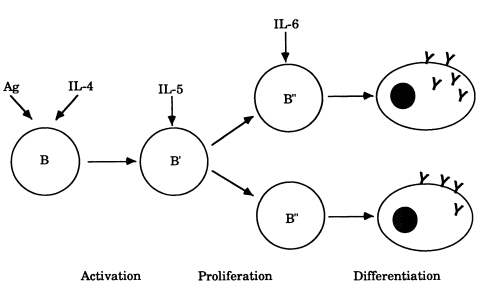Interleukin 6 - Info
Interleukin 6
Interleukin 6 (IL6) is a polypeptide mediator regulating the innate and acquired immune responses. This immunological switch is achieved by differential control of leukocyte recruitment, activation, and apoptosis [1]. Furthermore, it has been demonstrated that deregulated production of IL-6 is involved in a variety of chronic inflammatory diseases [2]. The cDNA for Interleukin (IL6) encodes for a polypeptide made of 212 amino acids. Via post- translational modification it is then made into a mature protein made of 185 amino acids. Further post – translational modifications consist of glycosylation and phosphorylation. This leads to varying molecular weights between 21,5 kDa and 18 kDa. IL6 is always glycosylated postions 73 and 172 [3].
Figure 1. Process of B-cell differentiation and interleukins involved in the process [4].

Applications
Since interleukin 6 plays an important role during the immune response, it can be used as a marker for inflammatory processes. Interleukin 6 can be detected in human serum, plasma, buffered solutions, and supernatants or in tissues. For such analysis, various (immunological) methods are available. These include methods such as e.g. ELISA, CLIA, Immunohistochemistry (IHC), Western Blot and many more.
References
|
[1] |
Jones, S. A. (2005). Directing transition from innate to acquired immunity: defining a role for IL-6. The Journal of Immunology, 175(6), 3463-3468. |
|
[2] |
Hirano, T., & Kishimoto, T. (1990). Interleukin-6. In Peptide growth factors and their receptors I (pp. 633-665). Springer Berlin Heidelberg. |
|
[3] |
Somers, W., Stahl, M., & Seehra, J. S. (1997). 1.9 Å crystal structure of interleukin 6: implications for a novel mode of receptor dimerization and signaling. The EMBO journal, 16(5), 989-997. |
|
[4] |
Kishimoto, T. (1989). The biology of interleukin-6. Blood, 74(1), 1-10. |
|
|
|



